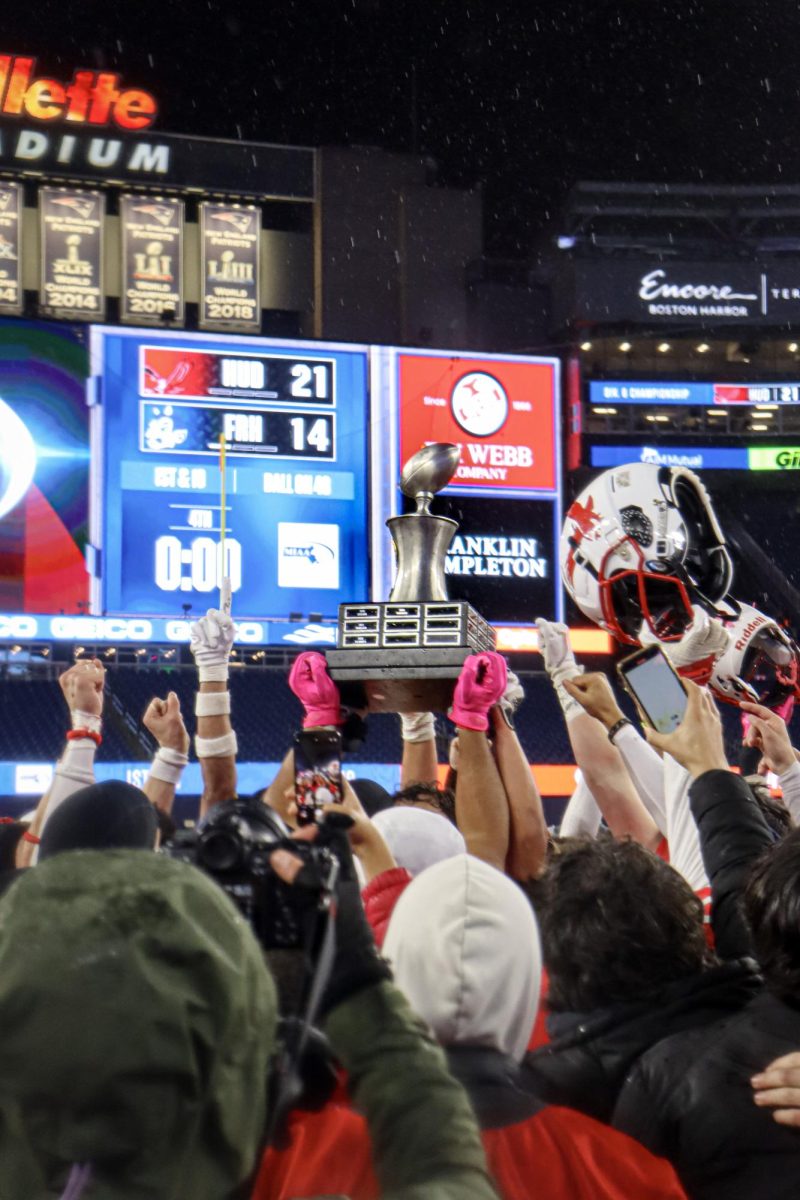by Leia Owen
Health consciousness is the “new norm.” Magazines and television shows depict tall men with toned muscles and thin women with little clothing, advertising the best way to get “six-pack abs” or “lean legs.” Obesity rates are rising. According to a report from 2011, the Department of Public Health stated that 35% of students at Hudson High are overweight or obese. School lunches are changing. Options are not only healthier foods, but each meal is limited to a maximum of 850 calories. Americans live in a food and diet-obsessed culture, and body image is certainly a concern.
“I feel pressured because actresses and models are all a size zero. They need to eat a cheeseburger or something!” said sophomore Sami O’Toole.
Celebrity measurements are available through Google, and cable television features mostly bare bodies. High school girls like Hanna Marin from Pretty little Liars struggle with bulimia to fit in with friends, and Rachel Berry from Glee spent an entire episode of the show contemplating plastic surgery for her nose. Media portrayal of beauty has gotten worse over the last fifty years; Marilyn Monroe was 5’5 1/2” and wore the equivalent of today’s size twelve, but Jennifer Lawrence is 5’9” and wears a size 6. Skinny is often interpreted as a prerequisite to being attractive.
“I feel like the media has a lot of influence on how we look and how we think about ourselves. This is just because all we see are the ‘pretty’ girls on t.v. The skinny girls with the nice smiles and the make-up. They’re the ones who get to sing, get to act, or get to dance,” said sophomore Lexi Hire. “You don’t see a fat person being the damsel in distress in a movie starring Leonardo DiCaprio. You see the media’s version of pretty. Similarly, you don’t see a fat boy portraying the hero who’s going to save Rachel McAdams. Everyone wants to be successful, so we act and try to look the way that the media wants us to in order to be noticed.”
So how much weight does weight really carry? For some, weight is not important. In fact, many students hardly worry about their weight at all. Sure, their appearance is important, but why should the number on the scale matter if you look good in yoga pants?
“Well, a lot of people say I should gain weight, but it’s not like something I can control,” said sophomore Sammy Myette.
However, other students think about it often. Athletes, actors, and artists alike all strive to look their best.
Performers worry about how they’ll look on stage, in pictures, and fear being “too wide” to fit in between curtains or set pieces while moving around backstage.Wrestlers go to extremes to make their weight classes, and even in the off season, they worry about how they look.
“When I can’t see my six pack, I freak out,” said wrestler Vinny Bonina. “I have to yell at my mom and tell her that we need to do something differently!”
Some parents even pressure students to change their habits and appearance. One mother urges her daughter to gain weight, and another has signed up her daughter to participate in a program called “Optimal Weight For Life” at a local hospital with a nutritionist, physician, behavioral therapist, and a physical adviser.
“My mom has pressured me to lose weight, but her opinion is that it isn’t healthy to be where I am at right now, not that I don’t look good,” said one student.
For many students, feeling good and being healthy are more important than being thin or attractive. However, that is not always the case. Eating disorders are a very real issue. Psychological, physical, and emotional effects of eating disorders are huge, but the struggle to be thin often outweighs the risks.
“My friend had an eating disorder, and she spent so much time focused on not eating or eating a certain amount of calories a day and having to exercise them away again,” said one senior. “Now I can’t help but do the same thing. I don’t blame her for it, but I do feel as though certain aspects of her destructive habits have rubbed off on me.”
Many girls struggle to attain “thigh gaps,” which is when your knees touch and your inner thighs do not. Not only is this unhealthy, but some bodies are just not capable of this. However, many girls at Hudson High have dreamed of or tried very hard to achieve this. Curves are healthier, and believe it or not, more preferred by men anyways. Multiple female students stated that they wish they had a “thigh gap,” and some even strive to reach this. On the contrary, all male students automatically responded that curves are much more appealing than empty space between a girl’s upper legs.
“The hardest part is that you’re never satisfied,” said one senior. “You’re either too thin and need to gain weight, or you’re too fat and need to lose weight. For some people, it is hard to gain weight, and once others begin to lose weight, it can be very difficult for them to stop.”
Girls with poor body image sometimes wear baggy or loose-fitting clothes and are often self-conscious in social situations. This can lead to behaviors such as isolation from peers and friends, eating disorders, and other destructive practice. These girls seek to hide their concerns about their bodies, as it turns many others away from them. Some bring very small lunches, or bring average-portion lunches but do not eat them. Others avoid the lunchroom all together, either to ensure that no one will discover their unhealthy habits or so they don’t have to worry about people watching them eating. Others count calories and exercise obsessively.
“Appearance, weight, body image… it is all very subjective. Beauty is in the eye of the beholder. And what is healthy or average for one person, can be unhealthy or too extreme for someone else,” said one junior.






Carol Hobbs • Mar 7, 2013 at 12:29 pm
Great article, Leah!